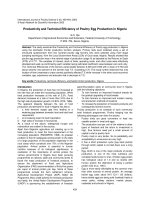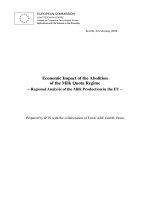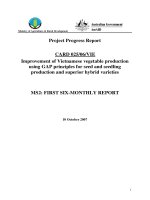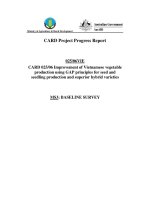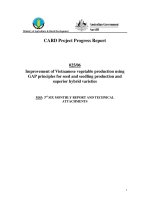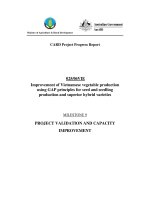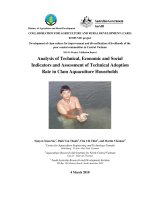optimisation of artemia biomass production in salt ponds in vietnam and use as feed ingredient in local aquaculture
Bạn đang xem bản rút gọn của tài liệu. Xem và tải ngay bản đầy đủ của tài liệu tại đây (1.4 MB, 296 trang )
Optimisation of Artemia biomass production in salt ponds in
Vietnam and use as feed ingredient in local aquaculture
Nguyen Thi Ngoc Anh
Promoter: Prof. Dr. Patrick Sorgeloos
Laboratory of Aquaculture & Artemia Reference Center
Faculty of Bioscience Engineering, Ghent University
Co-promoter: Dr. Nguyen Van Hoa
College of Aquaculture & Fisheries, Can Tho University, Vietnam
Dean: Prof. Dr. ir. Guido Van Huylenbroeck
Rector: Prof. Dr. Paul Van Cauwenberge
Examination Committee and Reading Committee (*):
Prof. Dr. ir. Jacques Viaene (Chairman)
Department of Agricultural Economics, Faculty of Bioscience Engineering, Ghent
University.
Prof. Dr. Peter Goethals (Secretary)
Department of Applied ecology and environmental biology, Faculty of Bioscience
Engineering, Ghent University.
Prof. Dr. Patrick Sorgeloos (Promoter), Department of Animal Production,
Faculty of Bioscience Engineering, Ghent University),
Prof. Dr. ir. Peter Bossier (Department of Animal Production, Faculty of Bioscience
Engineering, Ghent University),
*Dr. Nguyen Van Hoa (Co-promoter), College of Aquaculture & Fisheries, Can Tho
University, Vietnam.
*Prof. dr. Johan Mertens (Department of Biology, Faculty of Sciences, Ghent University)
*Prof. Dr. Josse De Baerdemaeker (Laboratory of Agricultural Machinery & Processing,
Department of Agro-Engineering and Economics, Katholic University of Leuven).
*Dr. Roeland Wouters (INVE Technologies, Belgium),
Nguyen Thi Ngoc Anh
Optimisation of Artemia biomass production in salt ponds in
Vietnam and use as feed ingredient in local aquaculture
Thesis submitted in fulfilment of the requirements for the degree of Doctor
(PhD) in Applied Biological Sciences
Dutch translation of the title:
Optimalisatie van Artemia biomassa productie in zoutpannes in Vietnam and gebruik als
voeder-ingredient in lokale aquacultuur
To cite this work:
Anh, N.T.N. (2009) Optimisation of Artemia biomass production in salt ponds in Vietnam
and use as feed ingredient in local aquaculture. PhD thesis, Ghent University, Belgium.
The author and the promoters give the authorisation to consult and to copy parts of this
work for personal use only. Every other use is subject to the copyright laws. Permission to
reproduce any material contained in this work should be obtained from the author.
ISBN 978-90-5989-308-5
This study was funded by Vietnamese government, PhD scholarship of the Vietnamese
Overseas Scholarship Program (322 project), and the CWO scholarship of the Faculty of
Bioscience Engineering, Ghent University, Belgium.
Acknowledgements
First of all, I would like to express my deep gratitude to my promoter, Prof. dr. Patrick
Sorgeloos for giving me the opportunity to study at Ghent University. His scientific
orientation, encouragement, and support during my four year study, especially his patience
in correcting the papers and final thesis drafts during his already busy time.
Special thank to my co-promoter Dr. Nguyen Van Hoa (Can Tho University, Vietnam) for
his scientific guidance, encouragement and experience on Artemia research.
My sincere thanks go to my supervisors Dr. Gilbert Van Stappen and Mathieu Wille for
their devoted and thoughtful revision and recommendations in the preparation and
completion of all chapters of the thesis.
I sincerely thank Prof. Dr. Josse De Baerdemaeker (Catholic University of Leuven,
Belgium), Nguyen Thuan Nhi (College of Technology, Can Tho University) for giving me
the basic knowledge and critical suggestions in the design of the experimental solar drier,
and Dr. Vu Quang Thanh for instruction in indoor drying techniques and allowing me to
utilize the drying machines and equipment, and Phan Thanh Dung for his help during the
drying experiment in the College of Technology, Can Tho University.
I am grateful to Prof. Dr. Truong Quoc Phu, Dr. Tran Thi Thanh Hien, Dr. Vu Ngoc Ut and
Duong Thuy Yen (College of Aquaculture and Fisheries, Can Tho University) for their
proper suggestions on experimental designs, feed formulation and for providing me with
facilities and space to perform the feeding trials.
I am greatly indebted to Peter Baert for his valuable recommendations with data-processing
on the Artemia experiments and also willing to help me whenever needed.
I am especially thankful to the members of the examination and reading committee, Prof.
Dr. ir. Jacques Viaene; Prof. Dr. Patrick Sorgeloos, Prof. Dr. ir. Peter Bossier, Prof. Dr.
Johan Mertens, Prof. Dr. Peter Goethals (Ghent University), Prof. Dr. Josse De
Baerdemaeker (Catholic University of Leuven), Dr. Nguyen Van Hoa (Can Tho University)
and Dr. Roeland Wouters (INVE Technologies NV, Belgium) for their critical reviews and
extremely valuable suggestions to improve this thesis.
My warmest thanks go to Magda Vanhooren, who kindly helped me whenever needed.
I am greatly indebted to Geert Van de Wiele and Anita De Haese for HUFA and proximate
composition analyses of the Artemia samples.
I deeply thank the staff of ARC: Dorina Tack, Alex Pieters, Marc Verschraeghen, Jean
Dhont, Bart Van Delsen, Kristof Dierckens, Marijke Van Speybroeck, Christ Mahieu,
Sebastiaan Vanopstal, Brigitte Van Moffaert, Tom Baelemans, Jorg De Smyter, for their
help with administrative matters.
Special acknowledgements are due to Prof. Dr. Nguyen Anh Tuan, the rector of Can Tho
University and Prof. Dr. Nguyen Thanh Phuong, the dean of the College of Aquaculture &
Fisheries, for allowing me to study abroad.
Many thanks to Dr. Duong Nhut Long, Dr. Nguyen Van Kiem, Dr. Tran Ngoc Hai and Dr.
Ngo Thi Thu Thao from the College of Aquaculture & Fisheries for their support and
providing me enough free time to accomplish this thesis.
I owe special thanks to my colleagues Huynh Thanh Toi for his endless kindness and all his
help in Ghent and in Vietnam, Nguyen Thi Hong Van for her provision of scientific
journals, encouragement and supporting experimental equipment, Tran Huu Le and Le Van
Thong for helping me with filtering chlorophyll a samples, transporting water samples to
Can Tho for analysis and biomass collection.
I greatly appreciate Le Van Nhieu, Phan Thanh Phuoc, Giang Van Nghiep, Giang Van Hay,
Nguyen Duyen Hai, Nguyen Thi Phuong, Tran Thi Yen who have been devoted hard
workers in Bac Lieu salt works and for their enthusiasm and efficient support during my
field study in Vinh Hau station, Bac Lieu province.
Many thanks to my PhD colleagues: El-Magsodi Mohamed, Natrah Ikhsan, Kartik Sri
Barua, Gunasekara Asanka, Dang To Van Cam, Le Hong Phuoc, Dinh The Nhan, Nguyen
Duy Hoa, Nhu Van Can, Ho Manh Tuan and others for their encouragement and support
during my study in Ghent.
To all Vietnamese students in Ghent, I thank you for your moral support during my stays in
Ghent. I would like to express my warmest feelings to all my friends and my colleagues in
various institutions and universities, Can Tho University and College of Aquaculture and
Fisheries, who always were concerned about my PhD completion.
I am very grateful to the Ministry of Education & Training, Vietnamese Government for
providing me with a scholarship to pursue my PhD study and the Faculty of Bioscience
Engineering, Ghent University, Belgium through the CWO scholarship for the defence of
this thesis.
My great gratefulness goes to my grandmother, my aunts, my brothers and sisters who
always encouraged me to finish my PhD, especially my mother who always gave me all
physical and moral support, but unfortunately does not live anymore.
I wish to dedicate this thesis to my husband Phan Huu Tam, who has sacrificed a lot during
my four years intensive study. This thesis is a present for him.
i
TABLE OF CONTENTS
Chapter 1 General introduction 1
Chapter 2 Literature review 7
Chapter 3 Culture of Artemia biomass
Section I Effect of partial harvesting strategies on Artemia biomass production in salt
works 31
Section II Effect of different food supplements on proximate compositions and
Artemia biomass production in salt works 47
Secttion III Effect of different ratios of N:P on primary productivity: its combination
with feeding strategies for Artemia biomass production in salt ponds 69
Chapter 4 Drying Artemia biomass
Section I Total lipid and fatty acid contents of Artemia biomass dried using different
drying techniques 109
Section II Effect of solar drying on lipid and fatty acid composition of dried Artemia
biomass 117
Chapter 5 Application of Artemia biomass for target aquaculture species
Section I Formulated feeds containing fresh or dried Artemia biomass as live food
supplement for larval rearing of black tiger shrimp, Penaeus monodon 151
Section II Effect of fishmeal replacement with Artemia biomass as protein source in
practical diets for the giant freshwater prawn Macrobrachium rosenbergii
141
Section III Effect of different forms of Artemia biomass as a food source on survival,
molting and growth rate of mud crab, Scylla paramamosain 157
Section IV Substituting fishmeal with Artemia meal in diets for goby
Pseudapocryptes elongatus: effects on survival, growth and feed
utilization 173
Chapter 6 General discussion and conclusions 207
Chapter 7 References 216
Summary/Samenvatting 239
Curriculum vitae 247
ii
List of abbreviations
Σ Total
°C Degree Cencius
ANOVA Analysis of variance
AOAC Association of Official Analytical Chemists
APHA American Public Health Association
ARA Arachidonic acid
BHT Butylated hydroxytoluene
C:N C-to-N ratio
C1 First crab stage
Ca Calcium
CF Commercial feed
cm Centimeter
CMI Cumulative mortality index
DA Dried Artemia
DHA Docosahexaenoic acid
DIN Dissolved inorganic nitrogen
DRP Dissolved reactive phosphorus
DW Dry weight
EFA Essential fatty acid
EPA Eicosapentaenoic acid
FA Fresh/frozen Artemia
FAME Fatty acid methyl easters
FAO Food and agriculture organization
FFA Free fatty acid
FM Fish meal
g Gram
GW Green water
h Hour
HA Hot air
HUFA Highly unsaturated fatty acid
L Liter
iii
LIA Linoleic acid
LNA Linolenic acid
min Minute
MKD Mekong delta
ml Milliliter
mm Millimeter
MoFI Ministry of Fisheries
MUFA Mono-unsaturated fatty acid
MW Microwave
N:P N-to-P ratio
P Phosphorus
PL Polar lipid
PL 15 Postlarvae 15
PM Pig manure
PUFA Poly-unsaturated fatty acid
RB Rice bran
SB Soybean meal
SE Standard error
SFA Saturated fatty acid
TAG Triacylglycerols
TAN Total ammonia nitrogen
TN Total nitrogen
TP Total phosphorus
VIAE Vietnam Institute of Agricultural Engineering
VND Vietnam dong
WW Wet weight
1
CHAPTER
General introduction and thesis outline
2
Chapter 1
1
General introduction
Populations of the brine shrimp Artemia (Crustacea, Anostraca) are typical inhabitants of
extreme environments, such as hypersaline inland lakes, coastal lagoons, and solar salt
works, distributed all over the world, and characterized by communities with low species
diversity and simple trophic structures (Lenz, 1987; Lenz and Browne, 1991). Artemia can
be found in a great variety of habitats in terms of water chemistry (Lenz, 1987; Bowen et
al., 1988), altitude (Triantaphyllidis et al., 1998; Van Stappen, 2002) and climatic
conditions, from humid-subhumid to arid areas (Vanhaecke et al., 1987).
The first use of Artemia nauplii, hatched from cysts, is known from the 1930s when this
zooplankton organism was used as a suitable food source for fish larvae in the culture of
commercially important species (Sorgeloos, 1980b; Léger et al., 1986). Since then, Artemia
has been found to be a suitable food for diverse groups of organisms of the animal
kingdom, especially for a wide variety of marine and freshwater crustaceans and fishes
(Sorgeloos, 1980b). Also decapsulated Artemia cysts, juvenile and adult Artemia have
increasingly been used as appropriate diets for different fish and crustacean species
(Sorgeloos et al., 1998; Dhont and Sorgeloos, 2002; Lim et al., 2003).
Since the early 1990s cyst consumption has increased exponentially as a consequence of the
rapidly expanding shrimp and marine fish industries (Sorgeloos et al., 2001; Dhont and Van
Stappen, 2003). On the other hand, the limited supply of Artemia cysts, originating from
natural harvests, may lead to a serious bottleneck in many aquaculture developments
(Lavens and Sorgeloos, 2000b). In particular, in South East Asia where no natural
populations of Artemia occur, therefore diversification of Artemia sources has been
considered a possible solution to sustain the fast growing aquaculture industry. This
strategy has been performed by the exploration of natural harvesting from new Artemia
sites such as China (Xin et al., 1994), Iran (Van Stappen et al., 2001), Mexico and Chile
(Castro et al., 2006) etc. Furthermore, man-made introduction of Artemia into saltworks
and man-made ponds has also contributed to supplement cyst supply. This approach has
been conducted during the last couples of decades in several countries with a monsoon
climate. For instance, Philippines (De Los Santos et al., 1980), Thailand (Tarnchalanukit
and Wongrat, 1987), Vietnam (Quynh and Lam, 1987; Brands et al., 1995) and other
countries such as India, Sri Lanka, Iran (Hoa et al., 2007).
Chapter 1
2
In Vietnam, Artemia production is successfully conducted on a seasonal basis in the
coastal areas of the Mekong Delta, southern Vietnam (Brands et al., 1995; Baert et al.,
1997). To date this region is an important supplier of high-quality Artemia cysts that are
used in domestic aquaculture as well as for export. This activity has had significant positive
socio-economic impacts for the local rural populations (Hoa et al., 2007; Son, 2008). In
practice, cysts produced during the previous culture season are used to establish, by
inoculation, a new population of Artemia. This practice may favour the accumulation of
adaptations to the new environment (Frankenberg et al., 2000). This Artemia culture system
is referred to as semi-intensive (Tackaert and Sorgeloos, 1991) and static (Quynh and Lam,
1987; Brands et al., 1995). Semi-intensive refers to small seasonal man-managed ponds in
which Artemia is inoculated at high densities (between 60 and 100 nauplii L
-1
). Ponds are
managed intensively (i.e. inoculation of selected strains, manipulation of primary and
secondary production, predator control, etc.) but most of the management procedures are
empirical. Furthermore, Artemia production in Vietnam has largely focused on cyst
production, and all techniques and methodologies developed to optimize Artemia
production have used maximal high-quality cyst production as their primary target (Brands
et al., 1995; Baert et al., 1997; Hoa et al., 2007).
Artemia is a non-selective particle feeder, feeding on microalgae, detritus and bacteria,
where the only limiting factor is the size of the ingested particles (Van Stappen, 1996;
Fernández, 2001; Dhont and Sorgeloos, 2002). Although the feeding and filtration biology
of Artemia has been studied in laboratory tests (Coutteau and Sorgeloos, 1989; Evjemo and
Olsen, 1999; Fernández, 2001), up to now, this type of study has not been extended to the
field, and there is very little information on optimal Artemia biomass production in salt
works. Artemia biomass is an excellent food source in aquaculture as it converts detritus
and phytoplankton into high-quality proteins, thus extracting nutrients from the aquatic
environment (Sorgeloos, 1985). Artemia biomass is valorised as a high-quality feed for
ornamental fish (Lim et al., 2001; 2003), as a nursery food for marine fish, shrimp, prawn
and crab (Merchie, 1996; Sorgeloos et al., 1998; Dhont and Sorgeloos, 2002), as an overall
high-protein ingredient for aquaculture feeds, and as maturation trigger in shrimp
broodstock (Naessens et al., 1997; Wouters et al., 2002).
In pond systems, the success of Artemia cyst and biomass production relies on the
favourable growth of the Artemia population after inoculation. This growth is, amongst
others, significantly influenced by the food management of the culture ponds. The final
Chapter 1
3
yield of Artemia biomass can also be considerably affected by various technical aspects,
such as harvesting strategies (Brands et al., 1995; Baert et al., 1996, Anh and Hoa, 2004).
Hence, substantial research is required to (1) optimize culture techniques, in particular in
relation to the effects of organic and inorganic fertilizers on the production of microalgae as
a natural food for Artemia, (2) on the use of supplementary feeds and (3) on adequate
harvesting strategies. Moreover, there is a need for (4) research into the possible
applications of Artemia biomass products in Vietnamese aquaculture. Farming of highly
valuable aquaculture species in the Mekong delta has been studied for several species such
as Penaeid shrimp (Nghia et al., 1997a,b; Phuong et al., 2008), freshwater prawn
Macrobrachium rosenbergii (Thang, 1995; Lan et al., 2006). Similar work exists for the
mud crab Scylla spp. (Dat, 1999; Ut et al., 2007a,b) and for different types of polyculture of
marine and freshwater species (Rothuis et al., 1998; Minh et al., 2001; Lan et al., 2003).
Recently, Vietnamese aquaculture activities have been expanding with the culture of new
target marine aquatic species such as swimming crab (Portunidae), cobia (Rachycentridae),
grouper (Serranidae), goby (Gobiidae), eel (Anguillidae), Areola babylon (Buccinidae), etc.
(MoFI, 2006). These new species offer opportunities for diversification in the use of
Artemia, including live juveniles and adults as well as frozen or dried Artemia biomass.
This indicates that there is a high potential market for Artemia biomass not only in the
Mekong Delta but also along the coast line of central Vietnam (Hoa et al., 2007).
Research objectives
The general objectives of this thesis are firstly to improve Artemia pond management in
terms of the supply of natural and supplementary foods, and by adaptation of biomass
harvesting strategies. It also aims to develop a simple and cheap processing technique for
Artemia biomass, resulting in a product which is suitable for application in local
aquaculture operations in the Mekong Delta.
Chapter 1
4
The specific objectives and the thesis outline are as follows:
Chapter 1 (General introduction and thesis outline) describes an outline covering the
main topics of this thesis.
Chapter 2 (Literature study) presents the biology and ecology of Artemia, and gives an
overview of aquaculture as well as the history of Artemia study in Vietnam. It comprises
general geographic and climatological information on the site where the field research has
been conducted. It describes the general principles of Artemia biomass pond production in
this area, and its various applications in local aquaculture. It also provides a summary of
drying methods currently used in food and feed processing technology.
Chapter 3 (Culture of Artemia biomass) describes the experimental work aiming to
optimize Artemia biomass production in salt ponds. This chapter consists of three parts:
- Effect of partial harvesting strategies on Artemia biomass production in salt works
(Section I)
- Effect of different food supplements on proximate compositions and Artemia biomass
production in salt works (Section II)
- Effect of different ratios of N:P on primary productivity: its combination with feeding
strategies for Artemia biomass production in salt ponds (Section III)
Chapter 4 (Drying Artemia biomass) describes tests aiming to work out a simple and
cheap drying method for Artemia biomass, resulting in a product with appropriate quality
for use in aquafeeds. It comprises two parts:
- Total lipid and fatty acid contents of Artemia biomass dried using different drying
techniques (Section I)
- Effect of solar drying on lipid and fatty acid composition of dried Artemia biomass
(Section II)
Chapter 1
5
Chapter 5 (Application of Artemia biomass for some target aquaculture species)
evaluates the potential uses of different Artemia biomass preparations as feeds in the
larviculture and nursery phases of the important cultured species in the Mekong delta. It
contains four parts.
- Formulated feeds containing fresh or dried Artemia biomass as live food supplement for
larval rearing of black tiger shrimp, Penaeus monodon (Section I)
- Effect of fishmeal replacement with Artemia biomass as protein source in practical diets
for the giant freshwater prawn Macrobrachium rosenbergii (Section II)
- Effect of different forms of Artemia biomass as a food source on survival, molting and
growth rate of mud crab Scylla paramamosain (Section III)
- Substituting fishmeal with Artemia meal in diets for goby Pseudapocryptes elongatus:
effects on survival, growth and feed utilization (Section IV)
Chapter 6 (General discussion) restates and discusses the overall results of the
experiments conducted in this thesis. Based on the discussion, the general conclusions are
drawn and prospective research topics are proposed.
Chapter 7 (References) contains all the bibliographic citations mentioned in this thesis.
Chapter 1
6
CHAPTER
Literature study
Chapter 2
7
Literature study
1. Overview of aquaculture in Vietnam
Globally, aquaculture is the fastest growing food-producing sector, with a total production
of almost 63 million metric tonnes in 2005, more than five times the amount produced in
1985. Asian countries play an important role in the development of the aquaculture sector,
accounting for more than 90% of global aquaculture production. Three quarters of global
aquaculture production is generated from Asian countries, with China and Vietnam ranking
as the first and third global producers. Among the top ten Asian producers, Vietnam
experienced the fastest growth between 1985 and 2005, which has raised concerns among
several stakeholders concerning the sustainability of the aquaculture sector in Vietnam
(Corsin, 2007).
Vietnam has great potential for aquaculture development including marine, brackish and
fresh waters, all of which are widely available throughout much of the country. There are
3,260 km of coastline, 12 lagoons, straits and bays, 112 estuaries, canals and thousands of
big and small islands scattered along the coast. On the land, an interlacing network of
rivers, canals, irrigation and hydroelectric reservoirs has created a great potential of water
surface with an area of about 1.7 million ha (Final report of Ministry of Fisheries (MoFI)
and World Bank, 2005).
In 2006, the total area of water surface used for aquaculture in Vietnam was 1,050 thousand
ha, which represents a 64% increase over the 641.9 thousand ha used in 2000. A variety of
species are cultivated in these waters, but shrimp and catfish are by far the most prevalent.
Total aquatic production increased almost 7% in 2006, while aquaculture production
increased 14.6% (Huong and Quan, 2007). The rapid development of the aquaculture sector
achieved during the last two decades has been a direct result of the sector diversifying its
farming practices and adapting to the production of exportable species at increased levels of
intensification. In 2007 the total aquaculture area accounted for more than one thousand
hectares and it was reported that the total aquaculture area and productivity have increased
2.1 and 2.5 times, respectively, compared to that in 1996. A similar tendency was also
found in the Mekong Delta (MKD) in South Vietnam (Figure 1). In addition, the total
output value of aquaculture in 2006 was 47,446.9 billion VNDs, which corresponds with a
Chapter 2
8
4.03 times increase, compared with 11,761 billion VNDs in 2000 (General Statistics Office,
2008; www.gso.gov.vn/default/news).
0
200,000
400,000
600,000
800,000
1,000,000
1,200,000
1996 1997 1998 1999 2000 2001 2002 2003 2004 2005 2006 2007
Culture area (ha)
0
1,000,000
2,000,000
3,000,000
4,000,000
5,000,000
Productivity (ton)
Total area MKD a rea Total productivity MKD productivity
Figure 1. Aquaculture culture area and productivity in Vietnam in general and in the
Mekong delta between 1996 and 2007 (Source: Data from General Statistics Office,
Vietnam, 2008)
The Mekong Delta has an area of 3.9 million ha, accounting for 12% of the total area of
Vietnam. Agriculture occupies 83% of the total delta so it plays an important role in the
development of the economy in Vietnam (Ni et al., 2003). In addition, this delta is the most
important region in Vietnam for both fisheries and aquaculture, accounting for 43 and 67 %
of the nation’s total production, respectively, and for 57 % of the total export values in
2003. The Mekong Delta has also the most diversified aquaculture farming activities and
has a large potential for increased aquaculture production (MoFI, 2005). The culture
systems include pond, fence and cage culture of catfish (Pangasius) as well as several
indigenous species such as snakehead fish (Channa), climbing perch (Anabas) and giant
freshwater prawn (Macrobrachium). Moreover, integrated farming systems such as rice-
cum-fish, rice-cum-prawn and mangrove-cum-aquaculture are broadly practiced across this
region (Minh et al., 2001; MoFI, 2006). Particularly, the Vietnamese Government has
promulgated a long term planning to develop sustainable aquaculture in the country,
namely “Decision No. 10/2006/QÐ-TTg dated Jan. 11, 2006.” The objectives of this plan
are the following: aquaculture production in 2010 will be about 2 million tonnes, including
Chapter 2
9
0.98 million tonnes from fresh water aquaculture and 1.02 million tonnes of marine and
brackish water aquaculture; 1.1-1.4 million ha of water bodies will be exploited for
aquaculture activities, of which there are 0.6 million ha of freshwater area and 0.7 million
ha of brackish water and marine areas. In parallel, applied research, education and training
activities have been developed to meet the need for the sustainable and effective
development of the fisheries sector, particularly in aquaculture during the period 2005-
2010.
2. Trends in the use of fishmeal in Vietnam
Since aquaculture is developing rapidly in Vietnam, the future demand for fish meal (FM)
as an ingredient in aquafeeds is expected to increase dramatically. FM availability in
Vietnam is low and FM produced domestically is mostly of poor quality because of
inadequate preservation of trash fish on board. Consequently, Vietnam only uses
domestically produced FM for livestock and some freshwater fish for grow-out feed as it is
generally of low quality. FM for higher quality feed for fish fingerlings and crustaceans is
imported and represents about 90% of the total FM used. Fish oil for aquafeed manufacture
is also imported (Edwards et al., 2004).
A prognosis made by MoFI (2006) shows that about 150,000-200,000 tonnes of FM will be
required over the next decade for aquaculture, two to three times the present level of use.
However, the price of imported FM continues to rise and therefore the development of
Vietnamese aquaculture will be influenced strongly by the price for FM and oil on the
international market (Edwards et al., 2004). Moreover, Huong and Quan (2007) reported
that the aquatic feed industry is scrambling to keep pace with increased demand for
commercially made feed from the booming aquaculture industry in the Mekong Delta
where the major aquaculture activities in Vietnam are located. Latest available statistics
indicate that Vietnam’s 39 industrial aquatic feed producers in 2001 had a production
capacity of about 50,000 tonnes year
-1
. This would only satisfy about 40% of today’s
aquaculture feed demand. More and more the trend among farmers is to replace traditional
home-made feed with industrial feed, hence the higher demand for industrial fish feed. Feed
cost may contribute to more than 50% of the total cost of an aquaculture operation.
Moreover, the MoFI target of 200,000 tons of marine fish by 2010 would in theory require
at least 2 million tonnes of trash fish based on current practices, which is unattainable
without investments in more efficient feeds and feeding practices. Consequently, due to the


